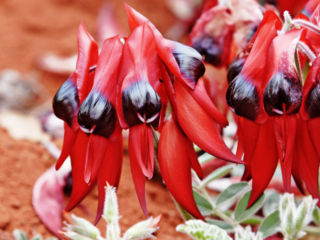
Swainsona formosa, commonly known as Sturt's desert pea or Sturt pea, is a species of flowering plant in the family Fabaceae and is native to all continental states and the Northern Territory of Australia, with the exception of Victoria. It is a prostrate annual or short lived perennial herb with imparipinnate leaves with about 15 elliptic to egg-shaped leaflets with the narrower end towards the base, and racemes of usually red flowers in racemes of 2 to 6.

Swainsona galegifolia commonly known as smooth Darling pea, is a species of flowering plant in the family Fabaceae and is endemic to Australia. It is a small shrub with greyish-green leaves and flowers in white, red, pink, purple, yellow or orange.

Swainsona greyana, commonly known as the Darling pea or hairy-Darling pea, is a species of flowering plant in the family Fabaceae and is endemic to south-eastern continental Australia. It is an erect perennial subshrub with imparipinnate leaves with 17 to 21 egg-shaped leaflets, and racemes of 12 to 20 or more white, pink or purple flowers.
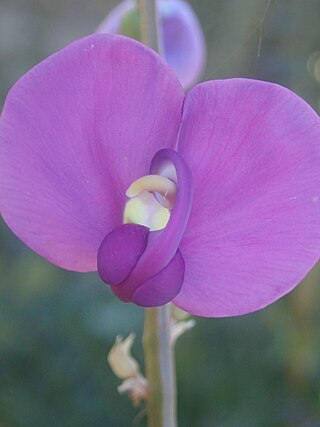
Swainsona procumbens, commonly known as Broughton pea or swamp pea is a species of flowering plant in the pea family (Fabaceae), and is native to Australia. It is a spreading or ascending perennial shrub-like herb with imparipinnate leaves with 15 to 25 linear to narrowly lance-shaped leaflets with the narrower end towards the base, and racemes of 2 to 12 purple or mauve to pink flowers.
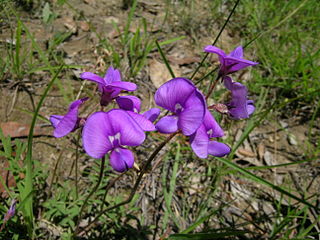
Swainsona monticola, commonly known as notched Swainson-pea, is a flowering plant in the pea family Fabaceae and grows in New South Wales and the Australian Capital Territory. It is an upright or sprawling perennial with fern-like leaves and purple pea flowers.

Swainsona maccullochiana, commonly known as Ashburton pea, is a species of flowering plant in the family Fabaceae. It is an upright annual with purple-reddish, pink or bluish pea-like flowers from spring to summer and is endemic to Western Australia.

Swainsona swainsonioides commonly known as downy Swainson-pea or downy Darling pea,is a flowering plant in the family Fabaceae. It is a small perennial herb with purple flowers and grows in eastern states of Australia.
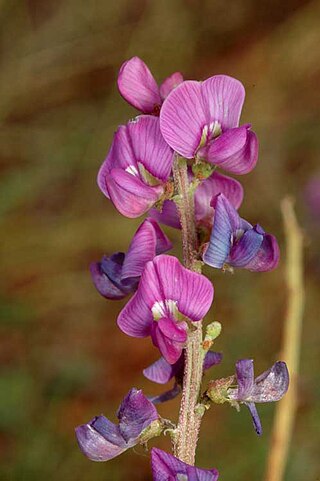
Swainsona affinis, commonly known as common poison pea, is a species of flowering plant in the family Fabaceae and is endemic to arid areas of inland Australia. It is a prostrate perennial herb with imparipinnate leaves with 7 to 25 broadly elliptic leaflets, and racemes of purple, pink, yellow or white flowers.

Swainsona brachycarpa, commonly known as slender swainson-pea, is a species of flowering plant in the family Fabaceae and is endemic to eastern Australia. It is a prostrate or ascending perennial herb with imparipinnate leaves usually with 9 to 13 egg-shaped to narrowly elliptic or egg-shaped leaflets, and racemes of up to 12 white, purple or dark red flowers.
Swainsona bracteata is a species of flowering plant in the family Fabaceae and is endemic to eastern Australia. It is a perennial herb with imparipinnate leaves usually with 19 to 25 narrowly egg-shaped leaflets, and racemes of about 20 white, pale pink or pale purple flowers.

Swainsona campylantha, commonly known as Gilgai Darling pea, is a species of flowering plant in the family Fabaceae and is endemic to inland areas of Australia. It is a low-growing perennial with imparipinnate leaves usually with up to 7 narrowly lance-shaped to narrowly elliptic leaflets, and racemes of 2 to 10 pink to purple flowers.
Swainsona fissimontana is a species of flowering plant in the family Fabaceae and is endemic to inland areas of southern continental Australia. It is a compact, erect or upright perennial herb with imparipinnate leaves with 7 to 13 narrowly elliptic to elliptic leaflets, and racemes of pink to dark purplish flowers in racemes of 3 to 11.
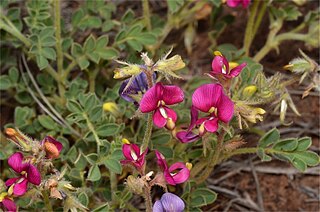
Swainsona flavicarinata is a species of flowering plant in the family Fabaceae and is endemic to inland areas of continental Australia. It is a prostrate to more or less erect perennial herb, with imparipinnate leaves with 5 to 9 egg-shaped leaflets with the narrower end towards the base, and racemes of 3 to 15 purple, red or pink flowers.
Swainsona fraseri is a species of flowering plant in the family Fabaceae and is endemic to eastern Australia. It is a perennial plant with imparipinnate leaves with mostly 21 to 24 ellipitic leaflets, and racemes of 20 or more pink to purple flowers.
Swainsona perlonga is a species of flowering plant in the family Fabaceae and is endemic to inland parts of the south-west of Western Australia. It is a scrambling perennial herb with imparipinnate leaves with 7 to 13 egg-shaped or almost round leaflets, and racemes of 7 to 10 purple to lilac-pink flowers.
Swainsona plagiotropis, commonly known as red swainsona-pea is a species of flowering plant in the family Fabaceae and is endemic to eastern continental Australia. It is a prostrate or ascending perennial herb with imparipinnate leaves with 13 to 25 narrowly egg-shaped or narrowly lance-shaped leaflets and racemes of 2 to 5 reddish-purple flowers.

Swainsona purpurea, commonly known as purple Swainson-pea or purple Darling pea, is a species of flowering plant in the family Fabaceae and is endemic to arid areas of inland Australia. It is an erect or spreading annual or perennial plant with imparipinnate leaves with 3 to 11 mostly linear or elliptic leaflets, and racemes of 3 to about 20 purple flowers.
Swainsona pyrophila, commonly known as yellow Swainson-pea or yellow Darling pea, is a species of flowering plant in the family Fabaceae and is endemic to southern continental Australia. It is an erect or spreading annual or short-lived perennial plant with imparipinnate leaves with 15 to 19, mostly egg-shaped leaflets with the narrower end towards the base, and racemes of 15 to about 20 yellow flowers.
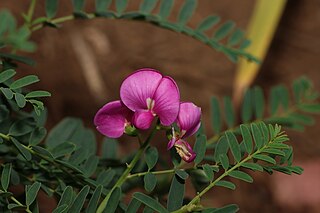
Swainsona queenslandica, commonly known as smooth Darling pea, is a species of flowering plant in the family Fabaceae and is endemic to eastern Australia. It is a perennial herb with imparipinnate leaves with 19 to 25 egg-shaped leaflets with the narrower end toward the base, and racemes of about 20 white, pinkish to orange red or dark red flowers.
Swainsona reticulata, commonly known as kneed Swainson-pea, is a species of flowering plant in the family Fabaceae and is endemic to south-eastern mainland Australia. It is a prostrate perennial herb, with imparipinnate leaves with 5 to 15 egg-shaped, elliptic or very narrowly linear leaflets, and racemes of 3 to 7 purple flowers.













